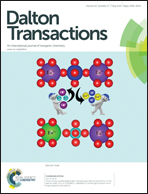Crystal structures, phase transitions, and switchable dielectric behaviors: comparison of a series of N-heterocyclic ammonium perchlorates†
Abstract
Three analogue N-heterocyclic complexes, 1-propyl-1-methylpiperidinium perchlorate (1, [PMpip][ClO4]), 1-cyanomethyl-1-methylpiperidinium perchlorate (2, [CMpip][ClO4]), and 1-cyanomethyl-1-methylmorpholinium perchlorate (3, [CMmor][ClO4]) are identified as phase transition materials displaying switchable dielectric behaviors. Despite the common [ClO4]− anion and the closely related cations, compound 1 crystallizes in the orthorhombic space group P212121, but compounds 2 and 3 belong to the monoclinic space group P21/n with distinct cell dimensions. Compounds 1, 2 and 3 undergo reversible phase transitions around 199, 387 and 416 K, respectively, accompanied by notable step-like dielectric anomalies which could be switched by the phase transition and be tuned in distinct dielectric states. The respective dielectric constants in the high dielectric states are 1.2, 2.2 and 3.2 times that in the low dielectric states for compounds 1, 2 and 3. Generally, these differences in the phase transitions and dielectric properties are caused by the distinct molecular structures and hydrogen-bonding conformations resulting from the structural variations in the side-chain and the ring structure.


 Please wait while we load your content...
Please wait while we load your content...